Key takeaways
- Kahoot enhances student engagement by providing a dynamic, interactive learning experience that invites all voices to participate.
- Activist teachers use Kahoot to facilitate discussions on social justice and real-world issues, creating an empowering classroom environment.
- Customized, relevant questions combined with varied formats maintain excitement and relevance, prompting deeper student investment.
- Future improvements for Kahoot could include deeper question formats and enhanced accessibility features to support diverse learners.
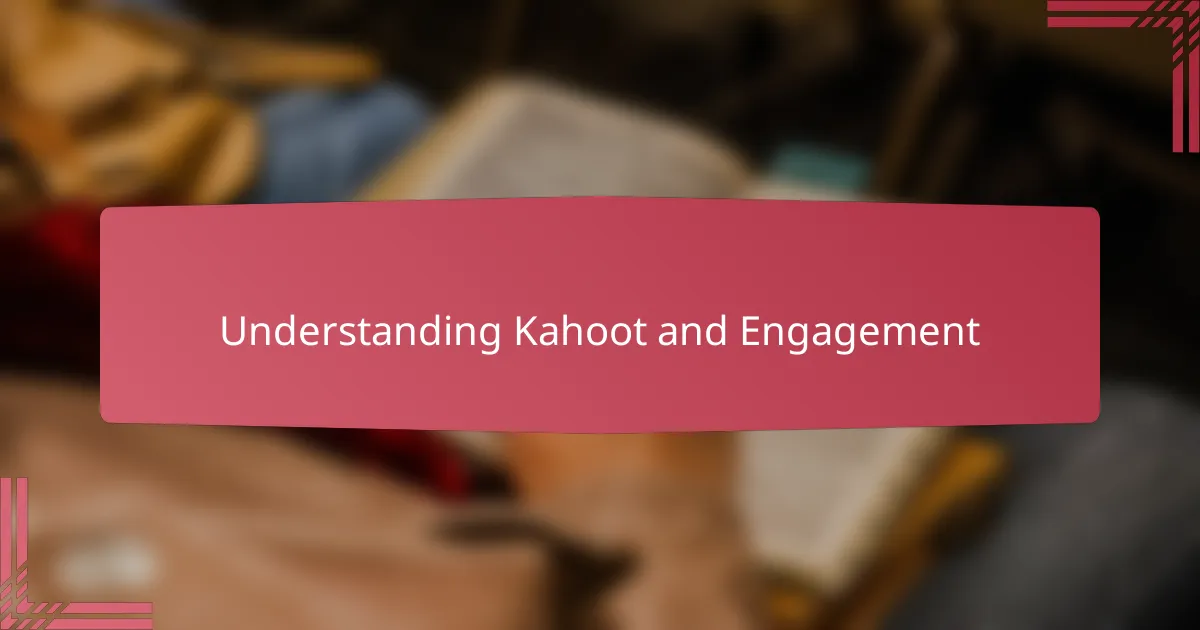
Understanding Kahoot and Engagement
Kahoot, at its core, is a game-based learning platform designed to spark interaction through quizzes and polls. From my experience, it’s not just the content but the fast-paced excitement that keeps students alert and curious. Have you ever noticed how a simple buzz of competition can transform a quiet room into a lively space of shared energy?
Engagement, in my view, thrives when learners feel active rather than passive. Kahoot’s real-time feedback and instant gratification tap into this need for participation, making the learning process feel dynamic and immediate. I’ve seen firsthand how even the shyest students lean in when there’s a challenge to be met or a score to beat.
But what truly fascinates me is how this tool bridges the gap between technology and personal connection. Does engagement purely come from fun, or is it also about feeling seen and involved? In my classroom, Kahoot isn’t just a quiz—it’s a moment where every voice counts, and that feeling alone can fuel deeper commitment to learning.
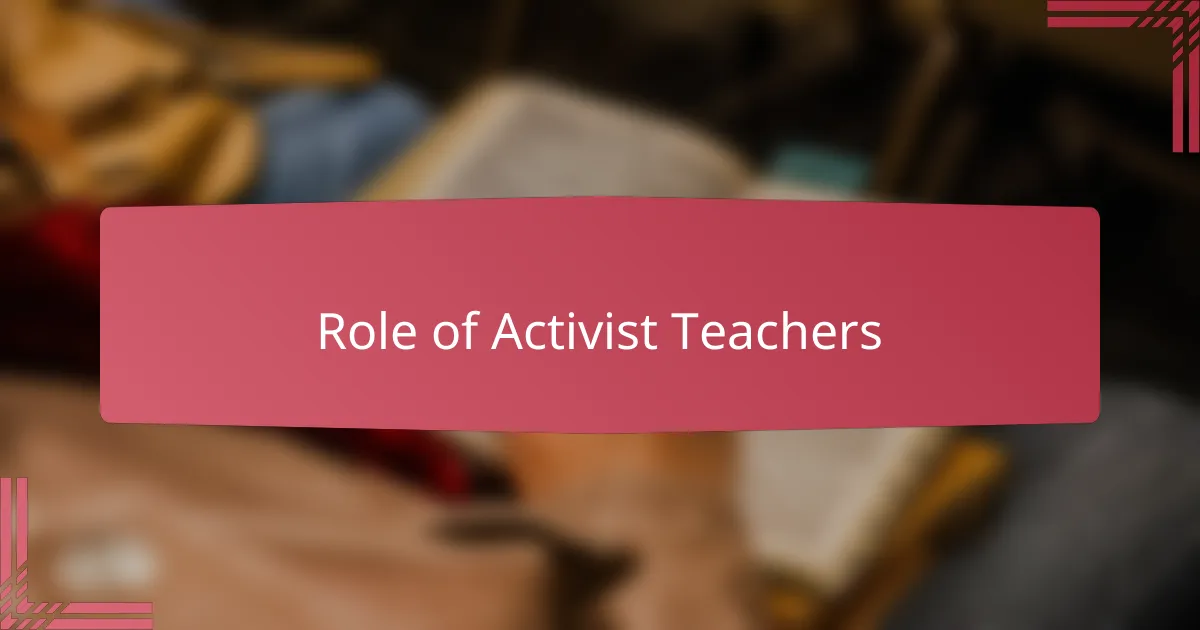
Role of Activist Teachers
Activist teachers, in my experience, are much more than educators—they are catalysts for change who use their classrooms as stages for critical thinking and social awareness. They challenge the status quo and inspire students to question, reflect, and act beyond the textbook. I often find myself asking: how can my teaching spark not just knowledge, but a desire for justice?
Their role isn’t limited to delivering content; it’s about creating spaces where students feel empowered to express themselves and engage with real-world issues. I recall moments when a classroom discussion, sparked by a simple question, transformed into a powerful exchange of ideas that resonated far beyond the lesson plan. This is the essence of activism in education—connection, courage, and community.
Ultimately, activist teachers navigate the tension between curriculum demands and the urgent call to nurture active citizens. Balancing these forces can be daunting, but it’s also deeply rewarding. I believe that when educators embrace this role wholeheartedly, they foster learners who don’t just absorb information but who are ready to contribute to meaningful social change.
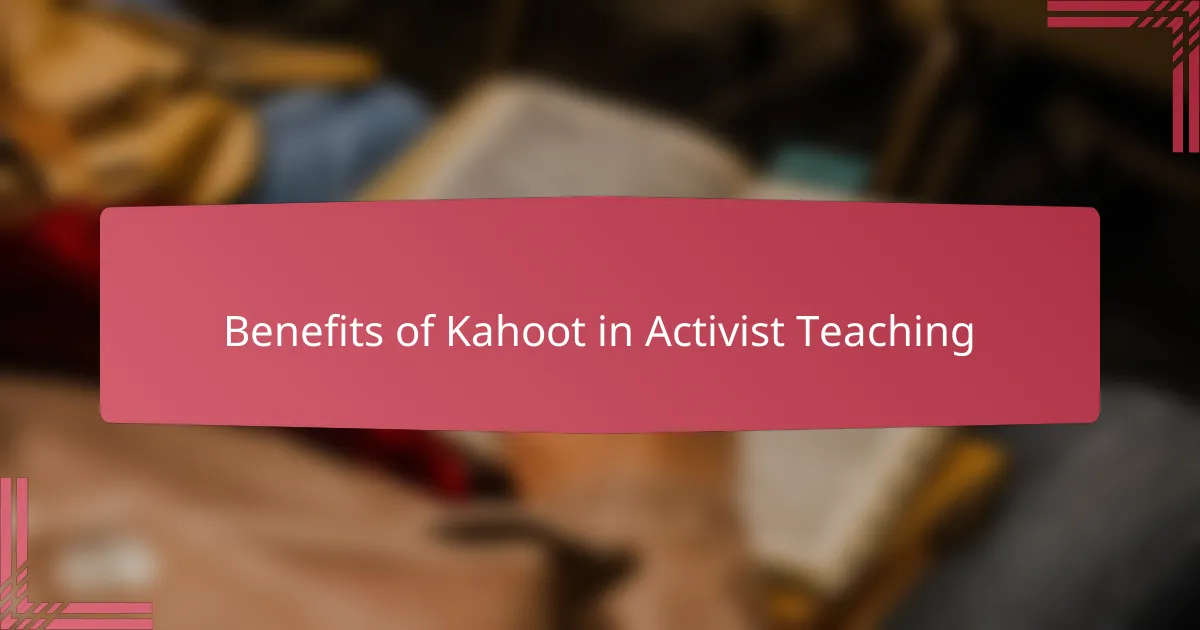
Benefits of Kahoot in Activist Teaching
What I find most powerful about Kahoot in activist teaching is how it instantly levels the playing field. Everyone—from the vocal leaders to the quiet thinkers—gets a chance to participate actively. Have you ever watched a student who usually stays on the sidelines suddenly light up as they answer a question correctly? That moment of confidence can ignite their passion for bigger conversations about justice and equity.
Kahoot also brings a sense of urgency and immediacy to discussions that might otherwise feel abstract. When students buzz in answers tied to real-world issues, the connection between knowledge and action becomes tangible. I remember using Kahoot to explore environmental justice topics; the energy in the room shifted palpably as facts turned into a shared call for awareness.
Moreover, the friendly competition Kahoot fosters sometimes breaks down barriers I hadn’t anticipated. Does gamifying sensitive topics risk trivializing them? In my experience, it doesn’t. Instead, it creates a safe but stimulating atmosphere where students can engage critically without fear. This balance is crucial when addressing complex social issues, making Kahoot a surprisingly effective ally in activist education.
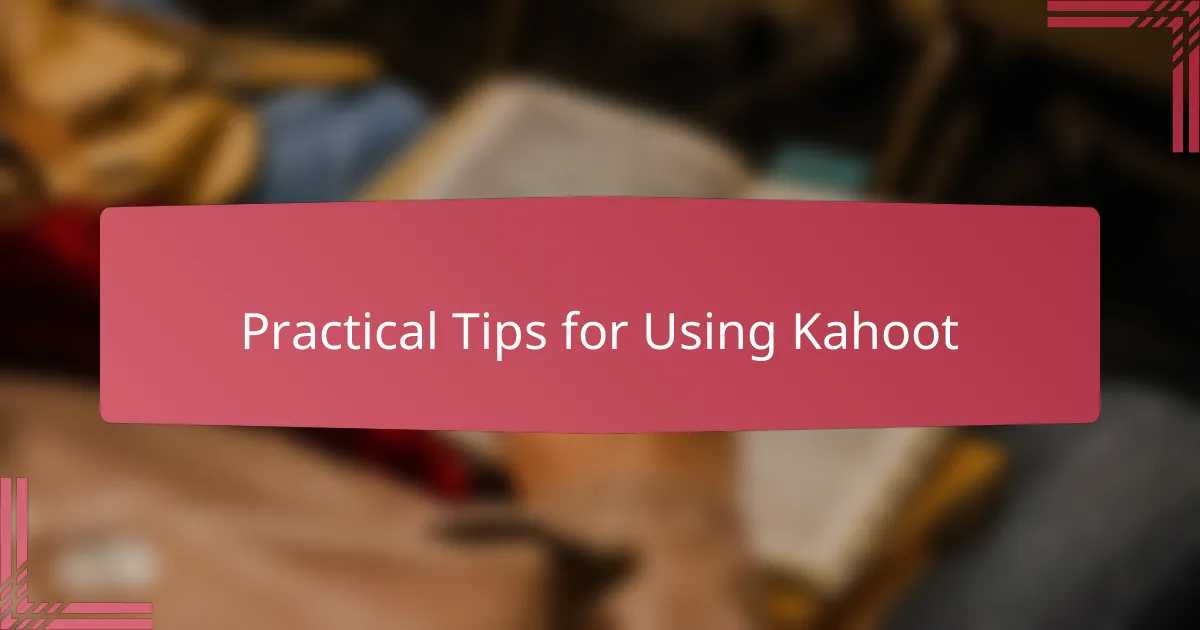
Practical Tips for Using Kahoot
One practical tip I’ve found invaluable is to keep Kahoot sessions short and focused. Too often, I see quizzes dragged out longer than they need to be, which can actually drain the very engagement we’re trying to build. By zeroing in on key questions that spark discussion, I maintain students’ energy and make the moments count.
Another strategy that’s worked well for me is customizing questions to include current activist issues or student interests. When learners see their realities reflected in the quiz, their investment skyrockets. Have you noticed how a question about climate justice or voting rights can instantly bring a classroom to life? It’s like the quiz transforms into a platform for real dialogue.
Finally, I always mix up the formats—using polls, true or false, and multiple choice—to keep the experience dynamic and unpredictable. This variety keeps students guessing and reduces monotony. It’s amazing how a simple change in question style can reset the room’s energy and bring even the most reluctant participants back into the game.
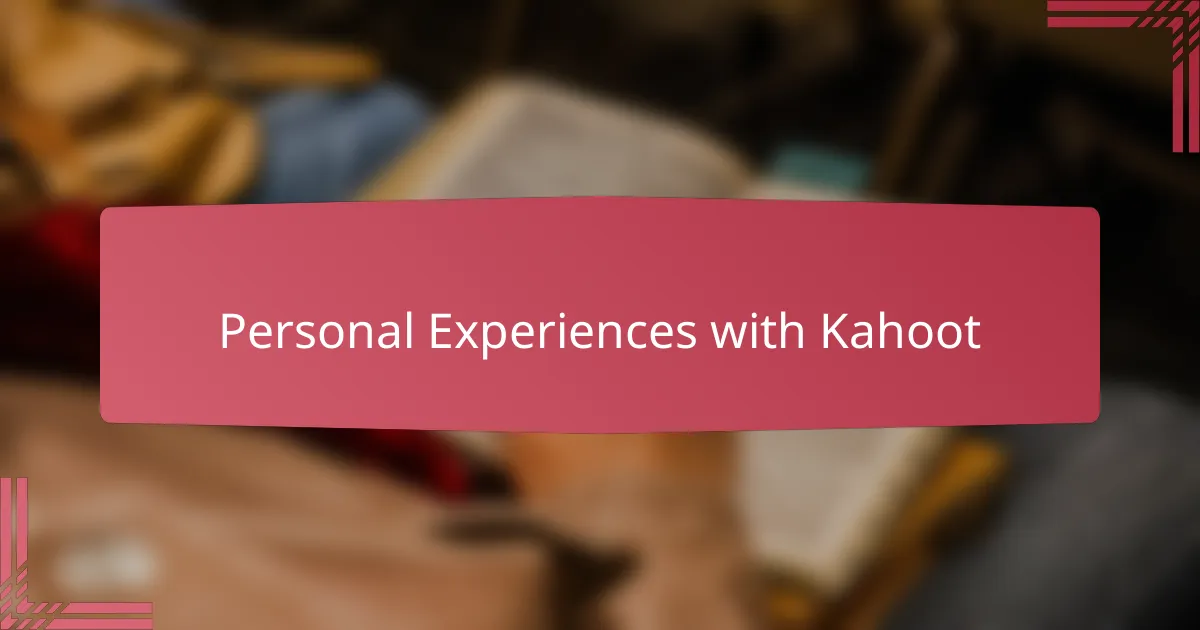
Personal Experiences with Kahoot
Using Kahoot has often surprised me by how quickly it shifts the energy in my classroom. I remember one session when a usually quiet student buzzed in first with the correct answer, her smile instantly brightening the room. That moment showed me how a simple game could uncover confidence hidden beneath shyness.
Sometimes, I catch myself marveling at how the timer on Kahoot creates this wonderful mix of excitement and urgency. Have you ever seen students lean forward, eyes darting between the screen and their devices, fully immersed? It reminds me that engagement isn’t just about the material—it’s about capturing that fleeting spark of motivation right when it matters.
That said, I’ve also noticed that not every Kahoot session hits the mark. There was a time when questions felt too disconnected from my students’ realities, and the buzz of enthusiasm quickly faded. It taught me the importance of tailoring content so that every quiz isn’t just a game but a meaningful experience that resonates personally with each learner.
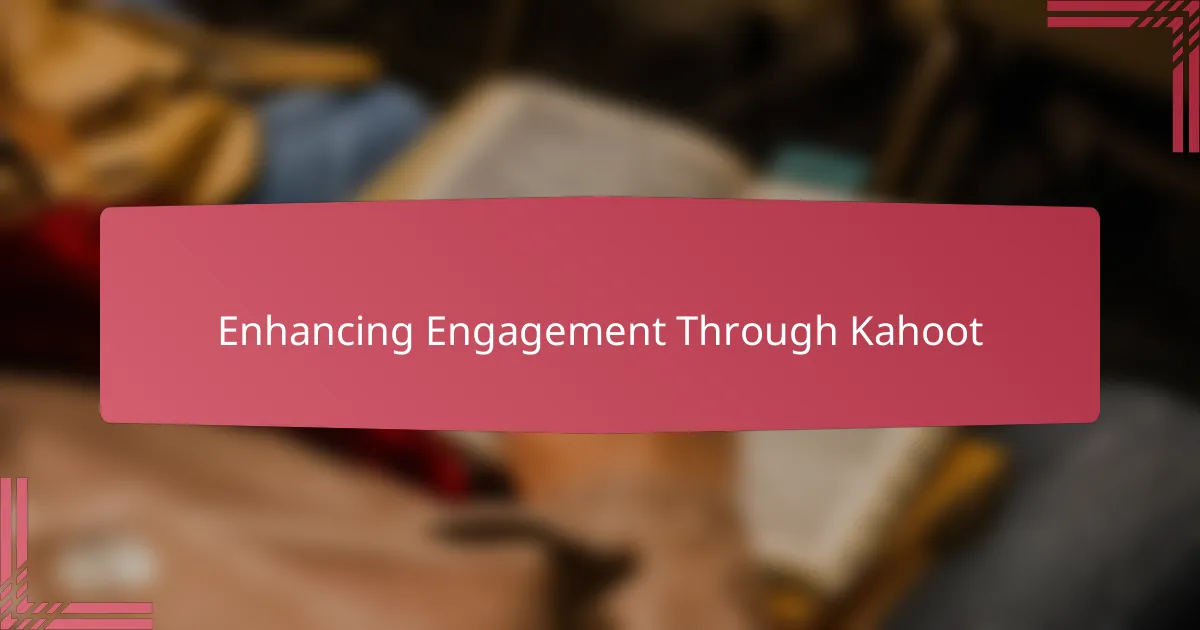
Enhancing Engagement Through Kahoot
Kahoot’s ability to boost engagement hinges on its immediacy and interactivity. I’ve seen classrooms transform when students race against the clock to answer a question—there’s this palpable sense of excitement that pulls everyone in. Doesn’t that instant spark make learning feel more like an adventure than a chore?
What strikes me most is how Kahoot invites every student to participate simultaneously, breaking down the usual barriers of hesitation. I recall moments when even the quietest learners couldn’t resist joining in, their faces lighting up as they competed. Could anything be more powerful in fostering a sense of belonging than seeing every voice actively contribute?
The platform also cleverly blends fun with focus, keeping energy levels high without sacrificing depth. From experience, mixing quick quizzes with meaningful content creates a rhythm that keeps students engaged long after the game ends. Have you noticed how that balance turns engagement into genuine curiosity?

Future Improvements for Kahoot Use
When I think about future improvements for Kahoot, one thing that stands out to me is the need for more nuanced question formats that support deeper reflection rather than rapid-fire answers. Could Kahoot evolve to include prompts that ask students to explain their reasoning or debate viewpoints? From my teaching experience, engagement deepens when learners are invited to think critically, not just quickly.
Another area ripe for enhancement is the platform’s accessibility features. Sometimes, I notice that students with diverse learning needs struggle to keep pace with the intense time limits or interface layout. What if Kahoot offered customizable timing or more inclusive design options? Making the tool adaptable to different learners would, in my opinion, elevate its role as an equitable educational resource.
Lastly, I dream of a Kahoot that seamlessly integrates follow-up discussions or collaborative projects linked directly to quiz outcomes. Imagine after a quiz on social justice topics, students could immediately jump into small group dialogues facilitated by the platform itself. Wouldn’t that kind of built-in extension deepen connection and sustain the powerful momentum Kahoot sparks in the classroom? From where I stand, these improvements would help turn a fun quiz into a profound learning experience.